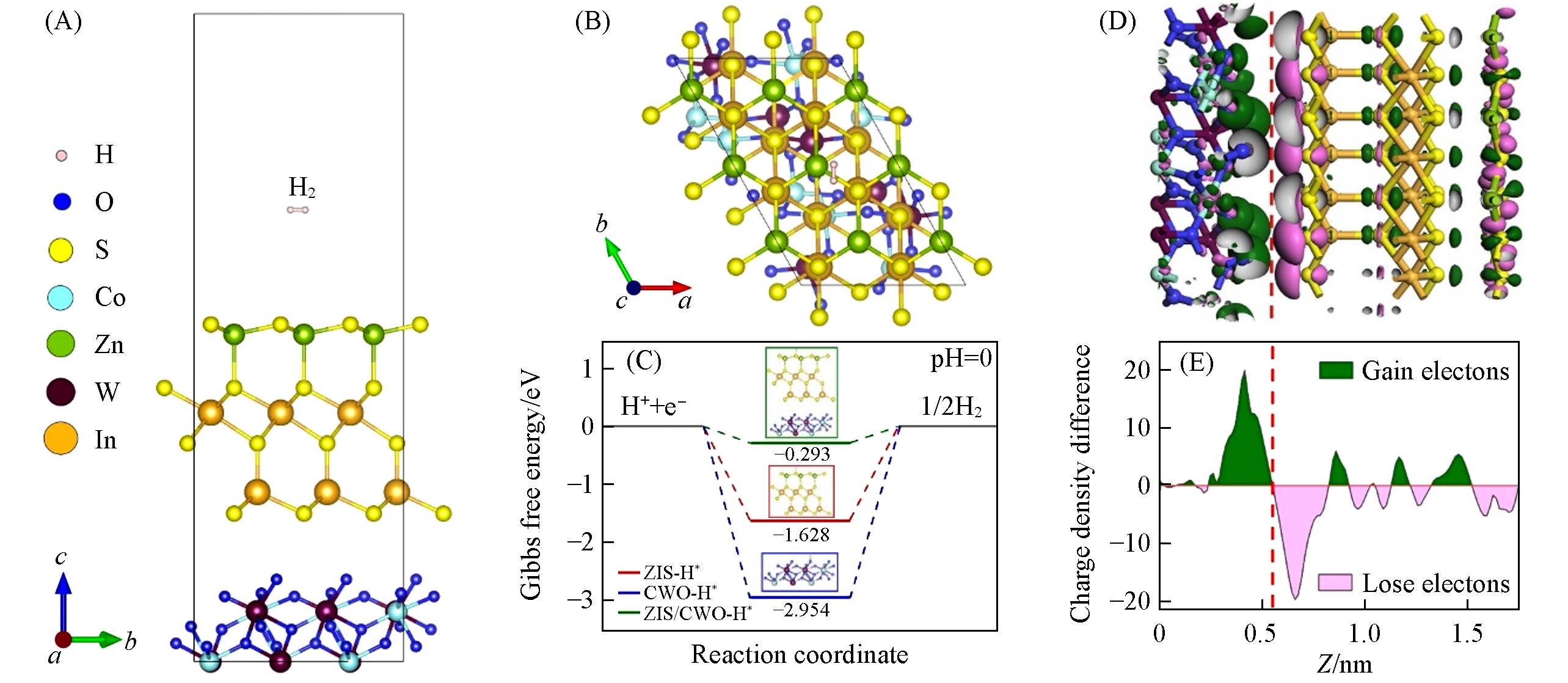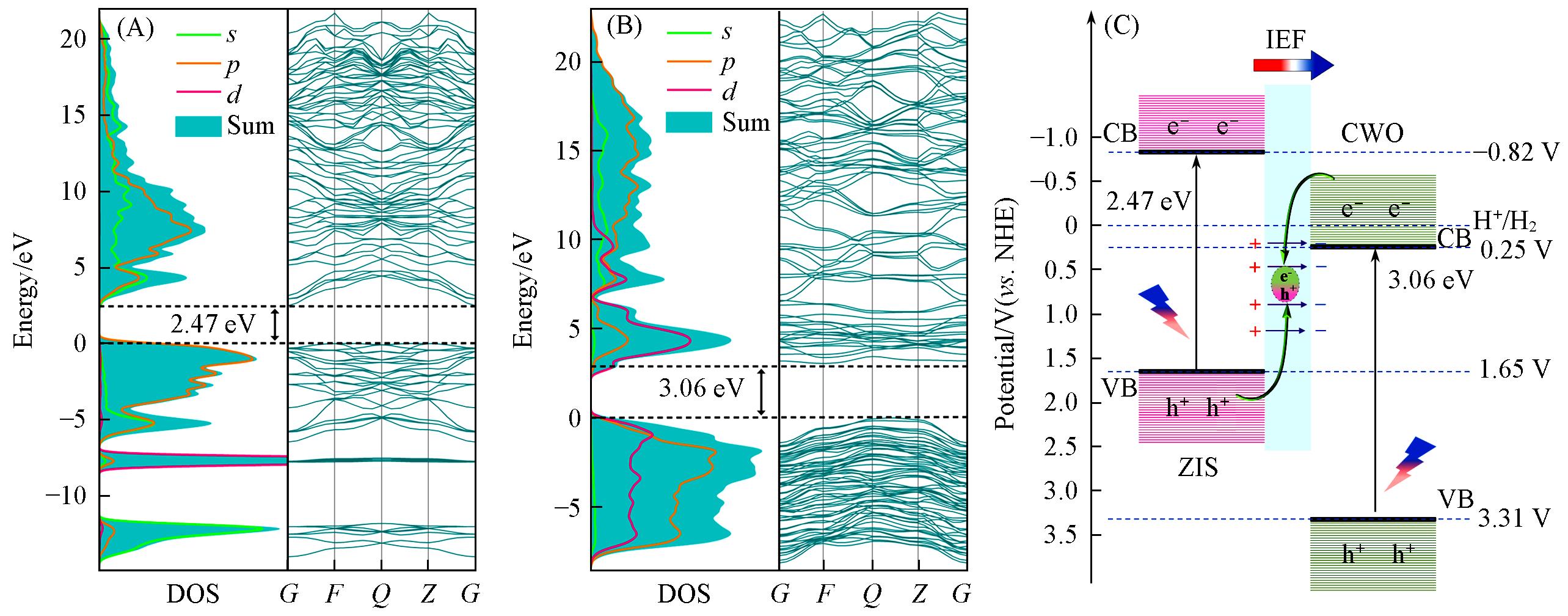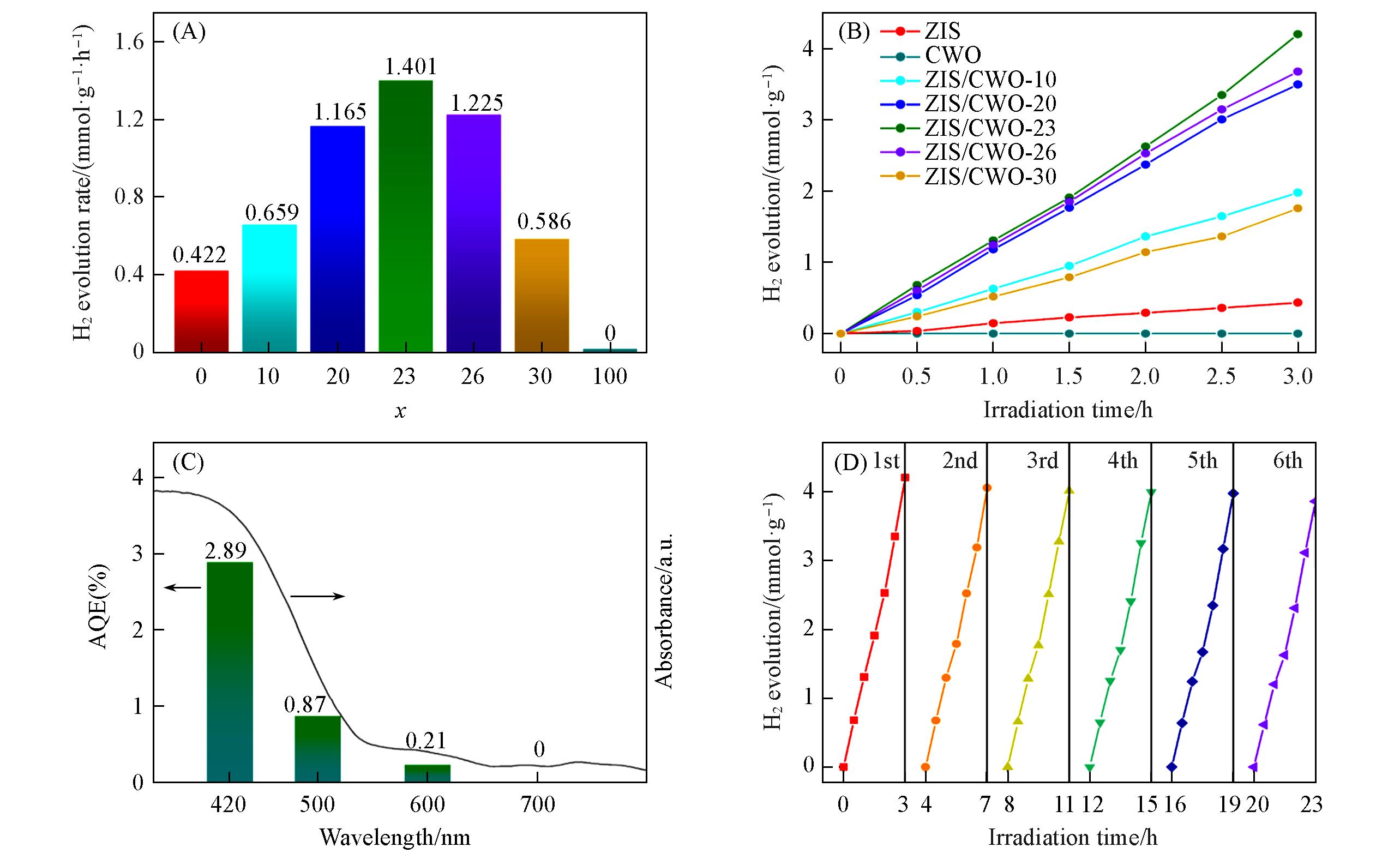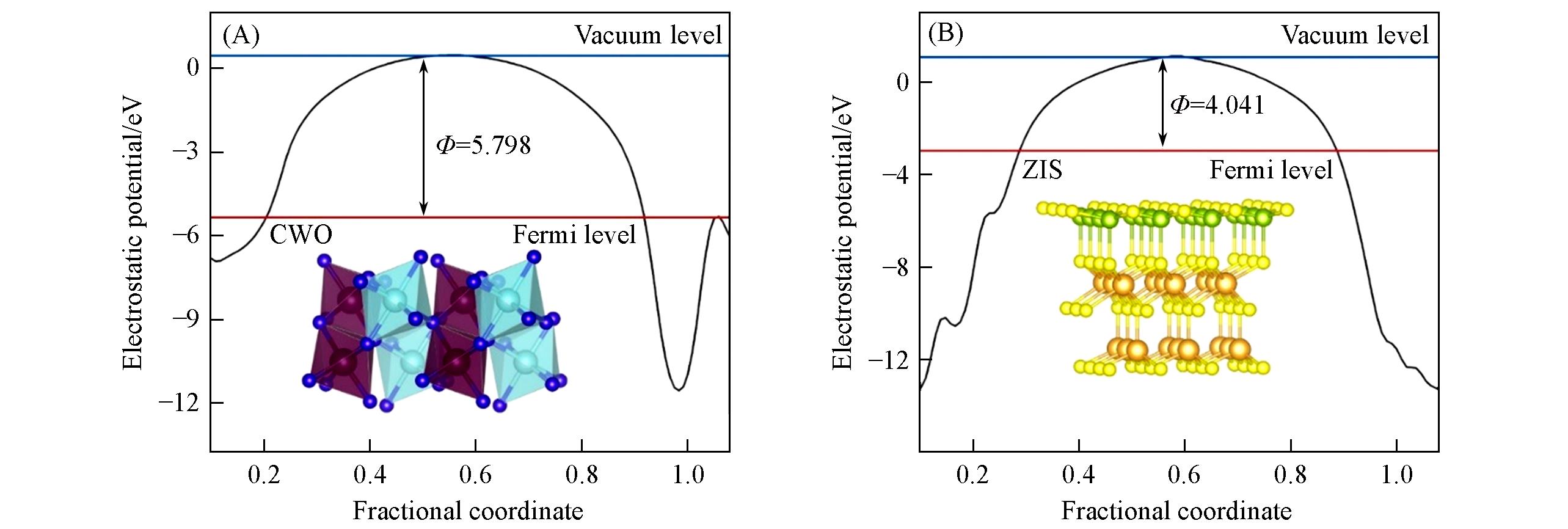

高等学校化学学报 ›› 2024, Vol. 45 ›› Issue (5): 20240055.doi: 10.7503/cjcu20240055
赵玉彤, 王仕凯, 赵福萍, 陈志合, 赵丽杰, 张大凤( ), 葛博, 蒲锡鹏(
), 葛博, 蒲锡鹏( )
)
收稿日期:2024-01-29
出版日期:2024-05-10
发布日期:2024-03-13
通讯作者:
张大凤,蒲锡鹏
E-mail:dafengzh@hotmail.com;puxipeng@lcu.edu.cn
基金资助:
ZHAO Yutong, WANG Shikai, ZHAO Fuping, CHEN Zhihe, ZHAO Lijie, ZHANG Dafeng( ), GE Bo, PU Xipeng(
), GE Bo, PU Xipeng( )
)
Received:2024-01-29
Online:2024-05-10
Published:2024-03-13
Contact:
ZHANG Dafeng, PU Xipeng
E-mail:dafengzh@hotmail.com;puxipeng@lcu.edu.cn
Supported by:摘要:
通过合理设计异质结结构来加速光催化产氢反应在高效光催化材料的开发中发挥着不可或缺的作用. ZnIn2S4(ZIS)由于其优异的光电性能和较负的导带位置, 在光催化产氢领域受到了广泛关注, 但其仍存在严重的光生载流子复合和团聚问题. 为此, 首先通过理论计算预测了ZnIn2S4/CoWO4(ZIS/CWO) S型异质结的能带结构及电子转移路径, 并通过电子局域函数和电荷密度差分确定了异质结界面处的电子交换. 随后, 采用超声-搅拌-煅烧法将CWO纳米颗粒分散并负载到ZIS花球表面, 获得了绣球花状ZIS/CWO S型异质结光催化剂. 由于ZIS与CWO之间紧密的界面以及形成的内部电场, 致使ZIS/CWO S型异质结的光生电子-空穴对得到了有效分离, 进而提高了光催化产氢效率. 同时, 实验结果确定了S型异质结的形成和载流子的传输路径, 揭示了光催化反应机理.
中图分类号:
TrendMD:
赵玉彤, 王仕凯, 赵福萍, 陈志合, 赵丽杰, 张大凤, 葛博, 蒲锡鹏. 绣球花状ZnIn2S4/CoWO4 S型异质结的构建及可见光催化产氢性能. 高等学校化学学报, 2024, 45(5): 20240055.
ZHAO Yutong, WANG Shikai, ZHAO Fuping, CHEN Zhihe, ZHAO Lijie, ZHANG Dafeng, GE Bo, PU Xipeng. Construction and Visible Photocatalytic Hydrogen Performance of Hydrangea-like ZnIn2S4/CoWO4 S-scheme Heterojunction. Chem. J. Chinese Universities, 2024, 45(5): 20240055.

Fig.1 DFT calculation results for ZIS/CWO S⁃scheme heterojunction(A, B) Atomic model and the diagram of surface H2 evolution; (C) free-energy diagram of photocatalytic H2 evolution; (D) simulated charge distributions diagram; (E) corresponding planar charge density difference curve at the ZIS/CWO interface.

Fig.2 DOS and calculated projected energy band of ZIS(A) and CWO(B), theoretical energy band structures and charge transfer mechanism diagram of ZIS/CWO S⁃scheme heterojunction(C)

Fig.6 Photocatalytic H2 evolution rates(A) and photocatalytic H2 evolution curves(B) of ZIS, CWO and ZIS/CWO S⁃scheme heterojunction, AQE and light absorption intensity changing curve with wavelength(C) and cycling performance curves(D) of ZIS/CWO⁃23 S⁃scheme heterojunction

Fig.10 Mean electrostatic potentials curves of CWO(A) and ZIS(B)(A) Internal illustration is the CWO structure used for calculation; (B) internal illustration is the ZIS structure used for calculation.
| 1 | Osman A. I., Elgarahy A. M., Eltaweil A. S., Abd El⁃Monaem E. M., El⁃Aqapa H. G., Park Y., Hwang Y., Ayati A., Farghali M., Ihara I., Al⁃Muhtaseb A. A. H., Rooney D. W., Yap P., Sillanpää M., Environ. Chem. Lett., 2023, 21(3), 1315—1379 |
| 2 | Ijaz M., Int. J. Hydrogen Energ., 2023, 48(26), 9609—9619 |
| 3 | Tang D., Tan G., Li G., Liang J., Ahmad S. M., Bahadur A., Humayun M., Ullah H., Khan A., Bououdina M., J. Energy Storage, 2023, 64, 107196 |
| 4 | Sun Y. G., Zhang H. Y., Ming T., Xu B. T., Gao Y., Ding F., Xu Z. H., Chem. J. Chinese Universities, 2021, 42(10), 3160—3166 |
| 孙亚光, 张含烟, 明涛, 徐宝彤, 高雨, 丁茯, 徐振和. 高等学校化学学报, 2021, 42(10), 3160—3166 | |
| 5 | Zhang L., Zhang J., Yu H., Yu J., Adv. Mater., 2022, 34(11), 2107668 |
| 6 | Yu J. H., Yao X. T., Su P., Wang S. K., Zhang D. F., Ge B., Pu X. P., J. Liaocheng Univ.(Nat. Sci. Ed), 2024, 37(1), 52—61 |
| 于佳慧, 姚欣彤, 苏萍, 王仕凯, 张大凤, 葛博, 蒲锡鹏. 聊城大学学报(自然科学版), 2024, 37(1), 52—61 | |
| 7 | Xue J. B., Gao G. X., Shen Q. Q., Liu T. W., Liu X. G., Jia H. S., Chem. J. Chinese Universities, 2021, 42(8), 2493—2499 |
| 薛晋波, 高国翔, 申倩倩, 刘天武, 刘旭光, 贾虎生. 高等学校化学学报, 2021, 42(8), 2493—2499 | |
| 8 | Li J., Wu C., Li J., Dong B., Zhao L., Wang S., Chin. J. Catal., 2022, 43(2), 339—349 |
| 9 | Li Y., Li Z., Liu E. Z., J. Liaocheng Univ.(Nat. Sci. Ed), 2023, 36(2), 1—10 |
| 李艳, 李卓, 刘恩周. 聊城大学学报(自然科学版), 2024, 36(2), 1—10 | |
| 10 | Zhao F., Li X., Zuo M., Liang Y., Qin P., Wang H., Wu Z., Luo L., Liu C., Leng L., J. Environ. Chem. Eng., 2023, 11(2), 109487 |
| 11 | Guo K., Hussain I., Jie G A., Fu Y., Zhang F., Zhu W., J. Environ. Sci. China, 2023, 125, 290—308 |
| 12 | Yang Q., Jiang Y., Zhuo H., Mitchell E. M., Yu Q., Nano Energy, 2023, 111, 108404 |
| 13 | Wang J., Sun S., Zhou R., Li Y., He Z., Ding H., Chen D., Ao W., J. Mater. Sci. Technol., 2021, 78, 1—19 |
| 14 | Xu L., Liu N., An H., Ju W., Liu B., Wang X., Wang X., Ultrason. Sonochem., 2022, 89, 106147 |
| 15 | Ma X. Q., Li X. B., Chen Z., Feng Z. J., Huang J. T., J. Inorg. Mater., 2023, 38(1), 62—70 |
| 马心全, 李喜宝, 陈智, 冯志军, 黄军同. 无机材料学报, 2023, 38(1), 62—70 | |
| 16 | Luo Q., Lu C., Liu L., Zhu M., Green Energy Environ., 2023, 8(2), 406—437 |
| 17 | Kong D., Ruan X., Geng J., Zhao Y., Zhang D., Pu X., Yao S., Su C., Int. J. Hydrogen Energ., 2021, 46(55), 28043—28052 |
| 18 | Paul Chowdhury A., Shambharkar B. H., Appl. Organomet. Chem., 2020, 34(4), e5436 |
| 19 | Jiang L., Wang K., Wu X., Zhang G., Yin S., ACS Appl. Mater. Inter., 2019, 11(30), 26898—26908 |
| 20 | Ghosh K., Giri P. K., Carbon, 2024, 216, 118515 |
| 21 | Chen C., Hou W., Xu Y., Appl. Catal. B, 2022, 316, 121676 |
| 22 | Peng X., Ye L., Ding Y., Yi L., Zhang C., Wen Z., Appl. Catal. B, 2020, 260, 118152 |
| 23 | Selvi S., Rajendran R., Barathi D., Jayamani N., J. Electron. Mater., 2021, 50(5), 2890—2902 |
| 24 | Gao Q., Sun G., Ling R., Cai Y., Wang A., J. Mater. Sci.: Mater. Electron., 2022, 33(34), 25589—25602 |
| 25 | Wang S., Zhang D., Zhang D., Pu X., Liu J., Li H., Cai P., J. Alloy. Compd., 2023, 967, 171862 |
| 26 | Yang R., Mei L., Fan Y., Zhang Q., Zhu R., Amal R., Yin Z., Zeng Z., Small Methods, 2021, 5(10), 2100887 |
| 27 | Zhang G., Wu H., Chen D., Li N., Xu Q., Li H., He J., Lu J., Green Energy Environ., 2022, 7(2), 176—204 |
| 28 | Yang H., Li J., Su Q., Wang B., Zhang Z., Dai Y., Li Y., Hou L., Chem. Eng. J., 2023, 470, 144139 |
| 29 | Sun G., Gao Q., Tang S., Ling R., Cai Y., Yu C., Liu H., Gao H., Zhao X., Wang A., J. Electron. Mater., 2022, 51(6), 3205—3215 |
| 30 | Jiang X., Kong D., Luo B., Wang M., Zhang D., Pu X., Colloids Surf. A: Physicochem. Eng. Asp., 2022, 633, 127880 |
| 31 | Su X., Wang A., Xu L., Zhang W., Guo F., Zhang D., Pu X., Cai P., J. Am. Ceram. Soc., 2023, 106(6), 3594—3604 |
| 32 | Wang S., Zhang D., Su P., Yao X., Liu J., Pu X., Li H., Cai P., J. Colloid Interf. Sci., 2023, 650, 825—835 |
| 33 | Kong D., Hu X., Geng J., Zhao Y., Fan D., Lu Y., Geng W., Zhang D., Liu J., Li H., Pu X., Appl. Surf. Sci., 2022, 591, 153256 |
| 34 | Su X., Wang S., Liu J., Zhang D., Pu X., Cai P., Chemosphere, 2023, 340, 139777 |
| 35 | Wang S., Su X., Han W., Xu G., Zhang D., Su C., Pu X., Cai P., Int. J. Hydrogen Energ., 2023, 48, 21712—21722 |
| 36 | Yao X., Zhen H., Zhang D., Liu J., Pu X., Cai P., Colloids Surf. A: Physicochem. Eng. Asp., 2022, 648, 129276 |
| 37 | Jin Z., Yan X., Hao X., J. Colloid Interf. Sci., 2020, 569, 34—49 |
| 38 | Wang B., Ding Y., Deng Z., Li Z., Chin. J. Catal., 2019, 40(3), 335—342 |
| 39 | Yang G., Zhang H., Dou M., Yang H., Yin X., Li D., Zhao H., Dou J., J. Colloid Interf. Sci., 2022, 610, 1057—1066 |
| 40 | Wang S., Guan B. Y., Wang X., Lou X. W. D., J. Am. Chem. Soc., 2018, 140(45), 15145—15148 |
| 41 | Yao X., Jiang X., Zhang D., Lu S., Wang M., Pan S., Pu X., Liu J., Cai P., J. Colloid Interf. Sci., 2023, 644, 95—106 |
| 42 | Su P., Kong D., Zhao H., Li S., Zhang D., Pu X., Su C., Cai P., J. Adv. Ceram, 2023, 12(9), 1685—1700 |
| 43 | Jiang J., Bai S., Yang M., Zou J., Li N., Peng J., Wang H., Xiang K., Liu S., Zhai T., Nano Res., 2022, 15(7), 5977—5986 |
| 44 | Ni Q., Ke X., Qian W., Yan Z., Luan J., Liu W., Appl. Catal. B, 2024, 340, 123226 |
| [1] | 熊文朋, 褚月英, 王强, 徐君, 邓风. 丙酮羰基13C化学位移表征分子筛限域效应的理论计算[J]. 高等学校化学学报, 2023, 44(8): 20230063. |
| [2] | 富忠恒, 陈翔, 姚楠, 余乐耕, 沈馨, 张睿, 张强. 固态电解质锂离子输运机制研究进展[J]. 高等学校化学学报, 2023, 44(5): 20220703. |
| [3] | 王斯阳, 敬稳, 常江伟, 卢思宇. 碳点的制备及电化学能源应用进展[J]. 高等学校化学学报, 2023, 44(5): 20220733. |
| [4] | 邓园, 王思, 丰海松, 张欣. Pd催化糠醛加氢反应中溶剂依赖效应的理论计算[J]. 高等学校化学学报, 2023, 44(2): 20220486. |
| [5] | 闫爱华, 高埜, 张晓辉, 黄飞, 张同洋, 张吉旭, 赵文学. p-n型NiWO4/ZnIn2S4异质结光解水析氢性能[J]. 高等学校化学学报, 2023, 44(12): 20230357. |
| [6] | 周颖, 贺培楠, 丰海松, 张欣. 双原子位点M-N-C电催化剂在CO2还原反应中活性位点的最佳分布[J]. 高等学校化学学报, 2022, 43(2): 20210640. |
| [7] | 姜珊, 申倩倩, 李琦, 贾虎生, 薛晋波. Pd增强缺陷态TiO2纳米管阵列的光催化产氢性能[J]. 高等学校化学学报, 2022, 43(10): 20220206. |
| [8] | 薛晋波, 高国翔, 申倩倩, 刘天武, 刘旭光, 贾虎生. 新型S型CdS-BiVO4异质结光电极的构筑及产氢性能研究[J]. 高等学校化学学报, 2021, 42(8): 2493. |
| [9] | 徐安琪, 李彬, 杜芳林. 有序介孔TiO2的合成及光解水产氢应用[J]. 高等学校化学学报, 2021, 42(4): 978. |
| [10] | 王非凡, 王松博, 姚柯奕, 张蕾, 杜威, 程鹏高, 张建平, 唐娜. 量子点自修饰TiO2p-n同质结的构建及光催化性能[J]. 高等学校化学学报, 2020, 41(7): 1615. |
| [11] | 曹锰, 柳阳, 张尚玺, 王振希, 徐胜. 壳聚糖钴配合物的合成及光催化产氢性能[J]. 高等学校化学学报, 2020, 41(4): 735. |
| [12] | 孙大伟,李跃军,曹铁平,赵艳辉,杨殿凯. 三维网状Dy 3+∶YVO4/TiO2复合纤维的制备及光催化产氢性能[J]. 高等学校化学学报, 2019, 40(11): 2348. |
| [13] | 闫璇, 薛冰纯, 刘二保. 水体系中尿素卤化铵共晶合成及影响因素的理论研究[J]. 高等学校化学学报, 2018, 39(12): 2700. |
| [14] | 蒋举兴, 王家俊, 段焰青, 刘亚, 王文元, 吴少华. 水催化2个酯分子相互转化反应的理论研究[J]. 高等学校化学学报, 2014, 35(9): 1919. |
| [15] | 曲阳, 周卫, 任志宇, 潘凯, 姜乐, 付宏刚. CdTiO3纳米棒的可控制备及光催化产氢性能[J]. 高等学校化学学报, 2014, 35(5): 995. |
| 阅读次数 | ||||||
|
全文 |
|
|||||
|
摘要 |
|
|||||